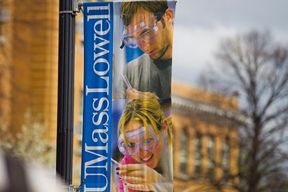Home > Press > UMass Lowell scientist pioneers new class of semiconductors: $1.7M NSF project aims to improve wireless communication, imaging, more
 |
Abstract:
A new class of faster, more powerful semiconductors for enhanced wireless communication and digital imaging is on the drawing board, thanks to research led by a UMass Lowell scientist.
UMass Lowell scientist pioneers new class of semiconductors: $1.7M NSF project aims to improve wireless communication, imaging, more
Lowell, MA | Posted on December 17th, 2021
Semiconductors transmit electricity. Also known as chips, they are found in countless products, including automobiles, computers, household appliances medical devices and smartphones.
UMass Lowell Physics Prof. Viktor Podolskiy is leading a research team that seeks to improve semiconductors used in infrared optoelectronic devices to enhance their performance. The project is a launching pad for new products with enhanced capabilities in intracellular imaging, night vision and quantum and 5G communication that could also better serve the Internet of Things (IoT).
A $1.7 million grant from the National Science Foundations Designing Materials to Revolutionize and Engineer Our Future (DMREF) program is funding the four-year project.
The funding enables us to essentially develop new materials for use and explore how light and matter interact within these materials. In the process of research, the team will train a next-generation workforce of scientists and engineers, Podolskiy said.
Infrared optoelectronic devices detect and convert light signals, or photons, into electric current, or electrons. The problem is the wavelengths of photons and electrons are naturally mismatched: Infra-red photons are fast and have very long wavelengths, while electron waves are much smaller and slower. In their work, the researchers will sculpt photons and electrons to more closely match their wavelengths to each other to improve semiconductor performance in these devices.
Joining Podolskiy on the team are researchers from Purdue University, the University of Texas-Austin and the University of Virginia.
If we are going to sustain innovation in communications and information processing, we must better understand and learn how to control both electronic and optical properties of these new semiconductor materials, said team member Avik Ghosh, University of Virginia professor of electrical and computer engineering and physics. I am really excited to work together with this amazing team.
The researchers plan to collaborate with the U.S. Air Force to use the materials the team develops for innovative and practical new devices, Podolskiy said.
####
About University of Massachusetts Lowell
UMass Lowell is a national research university located on a high-energy campus in the heart of a global community. The university offers its students bachelors, masters and doctoral degrees in business, education, engineering, fine arts, health, humanities, sciences and social sciences. UMass Lowell delivers high-quality educational programs, vigorous hands-on learning and personal attention from leading faculty and staff, all of which prepare graduates to be leaders in their communities and around the globe.
For more information, please click here
Contacts:
Nancy Cicco
University of Massachusetts Lowell
Office: 978-934-4944
Copyright © University of Massachusetts Lowell
If you have a comment, please Contact us.
Issuers of news releases, not 7th Wave, Inc. or Nanotechnology Now, are solely responsible for the accuracy of the content.
News and information
![]()
Nanoparticle therapeutic enhances cancer immunotherapy December 17th, 2021
![]()
Nanodiamonds are key to efficient hydrogen purification: Nanodiamonds may be tiny, but they can help with one of the biggest problems facing humanity today: Climate change December 17th, 2021
![]()
Oxford Instruments Atomfab® system is production-qualified at a market-leading GaN power electronics device manufacturer December 17th, 2021
Imaging
![]()
Development of a high-energy-resolution, LaB6 nanowire-based field emission gun: Electron source enables atomic resolution TEM observation December 10th, 2021
![]()
New microscopy method offers 3D tracking of 100 single molecules at once November 19th, 2021
![]()
Visualizing temperature transport: An unexpected technique for nanoscale characterization November 19th, 2021
Wireless/telecommunications/RF/Antennas/Microwaves
![]()
Thin-film, high-frequency antenna array offers new flexibility for wireless communications November 5th, 2021
![]()
Graphene nanotubes provide a shortcut to add conductivity to powder coatings October 1st, 2021
Govt.-Legislation/Regulation/Funding/Policy
![]()
Series of preclinical studies supports the Armys pan-coronavirus vaccine development strategy December 17th, 2021
![]()
Innovative silicon nanochip can reprogram biological tissue in living body December 10th, 2021
Possible Futures
![]()
Fabricating stable, high-mobility transistors for next-generation display technologies December 17th, 2021
![]()
Nanoparticle therapeutic enhances cancer immunotherapy December 17th, 2021
![]()
Nanodiamonds are key to efficient hydrogen purification: Nanodiamonds may be tiny, but they can help with one of the biggest problems facing humanity today: Climate change December 17th, 2021
Chip Technology
![]()
Fabricating stable, high-mobility transistors for next-generation display technologies December 17th, 2021
Discoveries
![]()
Fabricating stable, high-mobility transistors for next-generation display technologies December 17th, 2021
![]()
Nanoparticle therapeutic enhances cancer immunotherapy December 17th, 2021
![]()
Nanodiamonds are key to efficient hydrogen purification: Nanodiamonds may be tiny, but they can help with one of the biggest problems facing humanity today: Climate change December 17th, 2021
Announcements
![]()
Nanoparticle therapeutic enhances cancer immunotherapy December 17th, 2021
![]()
Nanodiamonds are key to efficient hydrogen purification: Nanodiamonds may be tiny, but they can help with one of the biggest problems facing humanity today: Climate change December 17th, 2021
![]()
Oxford Instruments Atomfab® system is production-qualified at a market-leading GaN power electronics device manufacturer December 17th, 2021










